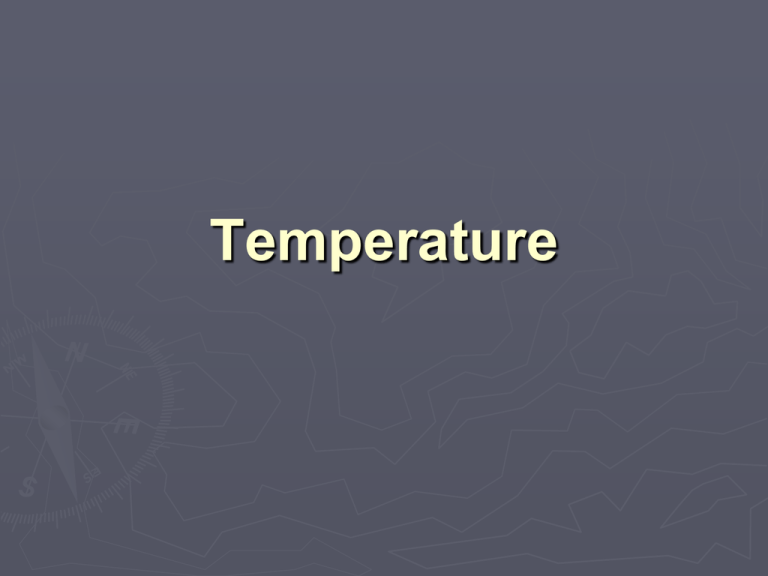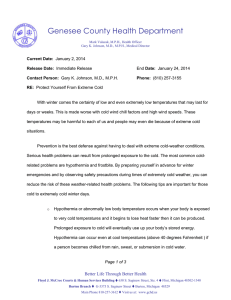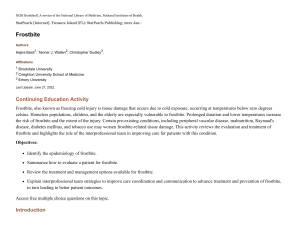Temperature
advertisement

Temperature a measure of the average speed at which molecules are moving or vibrating. Temperature scales Freeze Boil Celsius 0 100 Fahrenheit 32 212 Kelvin 273 373 Conversions ►oF = (1.8 x oC) + 32 ►oC = 0.56 (oF – 32) ►K = oC + 273 What Controls temperature? 1. Insolation differences (latitudinal , seasonal, daily) 2. Proximity to water bodies (land/water distribution) 3. Elevation 4. Ocean currents 5. Cloud Cover 1. Insolation a. Latitudinal ► High latitudes receive less insolation than low latitudes because… sun’s rays are more oblique Day length is variable Net energy surplus in tropics; net energy deficit in polar regions demonstrate b. Seasonal Changing angle of sun throughout the year changes temperature on a seasonal basis. c. Daily (diurnally) Changing angle of sun throughout the day changes temperature on a daily basis. Diurnal temperature pattern Temperature increases as long as net all wave incoming exceeds net all wave outgoing. Min: end of deficit Max: end of surplus 2. Proximity to water bodies ► Water bodies have a moderating effect on temperature. Maritime locations (coastal, island) have smaller daily and annual ranges in temp than continental locations demonstration ► Small effect from Lake Superior on Duluth temperatures Warmer winters, cooler summers near lake vs inland Top of the hill vs. harbor ►Harbor warmer in fall; cooler in spring ►Extreme example (May 2009) 3. Elevation ► Temperature decreases as elevation increases. less mass, less pressure, less absorption ► Review: ► Factors place: affecting the air temperature of a ►Insolation differences at various latitudes, during seasons, during the course of a day ►Proximity to big water bodies ►Elevation ►Ocean currents ►Cloud cover 5. Cloud Cover ► Exert influence on shortwave and longwave exchanges: Very efficient absorbers and emitters of longwave Reduce incoming shortwave ►High albedo ► Net Result: Dampen diurnal temp range ►Cloudy: uniform temps, small diurnal range ►Clear: daytime high insolation and nighttime loss of longwave; large diurnal range About cloud measurement Temperature and Human Comfort Comfort range: air temperature 68 - 77°F Outside comfort range, body will: ►Perspire ►Shiver ►Restrict/increase flow of blood to skin Humans are homeothermic Body regulates core temperature to within 3.6°F of 98.6° (95- 102.2) ►Hypothermia: Core drops below 95°F Violent shaking Lethargy Impaired speech Blurred vision Clumsy Degree of Hypothermia Signs and Symptoms Cardio-respiratory Response Level of Consciousness 95 F - Mild Shivering Foot Stomping Normal Withdrawn 90 F - Mild Loss of Coordination Normal to Impaired Confused 85 F - Moderate Lethargy Slow Pulse Sleepy 80 F - Severe Coma Weak Pulse Slow Respirations Irrational if Conscious 78 F - Severe Apparent Death V-Fib/Cardiac Arrest Unconscious Alcohol adds to danger ingestion increases the risk of acquiring or aggravating hypothermia by causing cutaneous vasodilation (which prevents vasoconstriction), impairment of the shivering mechanism, hypothalamic dysfunction, and a decrease in awareness of environmental conditions”. ► “Alcohol treatment ► ► ► ► ► ► ► ► Call 911 Get victim to warm place; otherwise don’t move them Remove wet clothing; replace with dry but minimize movement of person Warm core first before extremities Skin-to-skin contact in blanket or sleeping bag Do NOT RUB SKIN If victim can eat, give sweet food or drink (no alcohol or caffeine) Don’t elevate legs Legs are holding cold blood that would return to heart if legs are elevated ► Don’t give CPR unless not breathing or no pulse Victim may appear dead but can be resuscitated Frostnip vs. frostbite About 4,800 cases of frostbite occur in the United States each year. Frostnip is mild form of frostbite ► skin looks pale and feels cold, numb and stiff ► Yellowish or white ► underlying tissues remain warm and flexible ► uncomfortable but doesn’t lead to blisters, scarring or permanent damage ► minor but could lead to frostbite ► Second degree frostbite ► ► white or blue skin; feels hard and frozen. blisters after rewarming Third degree frostbite ► Tissue freezes ► Skin turns white, blue, black or mottled ► tissues beneath the skin feel hard and frozen. ► Deep tissue damage to blood vessels, nerves, tendons, muscle ► May require amputation Water immersion ► Can lead to hypothermia much more rapidly than simple cold temperatures ► Because than air water is a better conductor of heat Ice safety Wind chill ► Indoors: Body loses heat by ►Net radiation (60%) ►Evaporation from lungs, skin (25%) ► Outdoors: Body loses heat by ►Radiation ►Evaporation ►AND convection Wind chill equivalent temperature (W.E.T.) ► Temperature in still air that would correspond to the cooling generated by the combination of temperature and wind Body loses heat at a rate equivalent to conditions induced by calm winds at W.E.T. Hyperthermia ► Core goes above 102ºF Collapse Cramps Unconscious Stop sweating Headache, nausea, fatigue treatment ► Cool place ► Liquids (not alcohol or caffeine) ► Shower, bathe, sponge off with cool water ► rest Heat Stroke ► Temp > 104ºF ► confusion, combativeness, bizarre behavior ► faintness, staggering ► strong rapid pulse ► dry flushed skin, lack of sweating ► possible delirium or coma Heat Index ► Gauges combined effects of temperature and humidity; advise danger of heat stress Comfort depends on ability to lose heat through evaporation ►Need vapor pressure gradient between skin and air ►Evaporative cooling decrease as humidity increases ► Index: gives apparent temperature Temperature in dry air that would cause same level of discomfort Temperature inversion Annual March of the Seasons





